Audit and Assurance Theory: Audit Expectation Gap and Independence
VerifiedAdded on 2022/10/11
|8
|1701
|11
Report
AI Summary
This report, prepared for Samway Baker Fitzgerald (SBF), examines the audit expectation gap and threats to auditor independence concerning the audit of Bletchington Ltd, a major client. The report highlights the disparity between the public's expectations of auditors and the auditors' actual responsibilities, particularly in areas such as providing absolute assurance and guaranteeing future viability. It identifies and analyzes specific threats to auditor independence, including self-interest, self-review, and familiarity threats, detailing how these threats could arise within the context of Bletchington Ltd's operations and the relationship between SBF and its client. The report proposes safeguard measures to mitigate these threats, such as external reviews, ensuring the independence of internal audit teams, and implementing monitoring processes. The analysis is supported by relevant accounting literature and professional standards, such as APES 110.
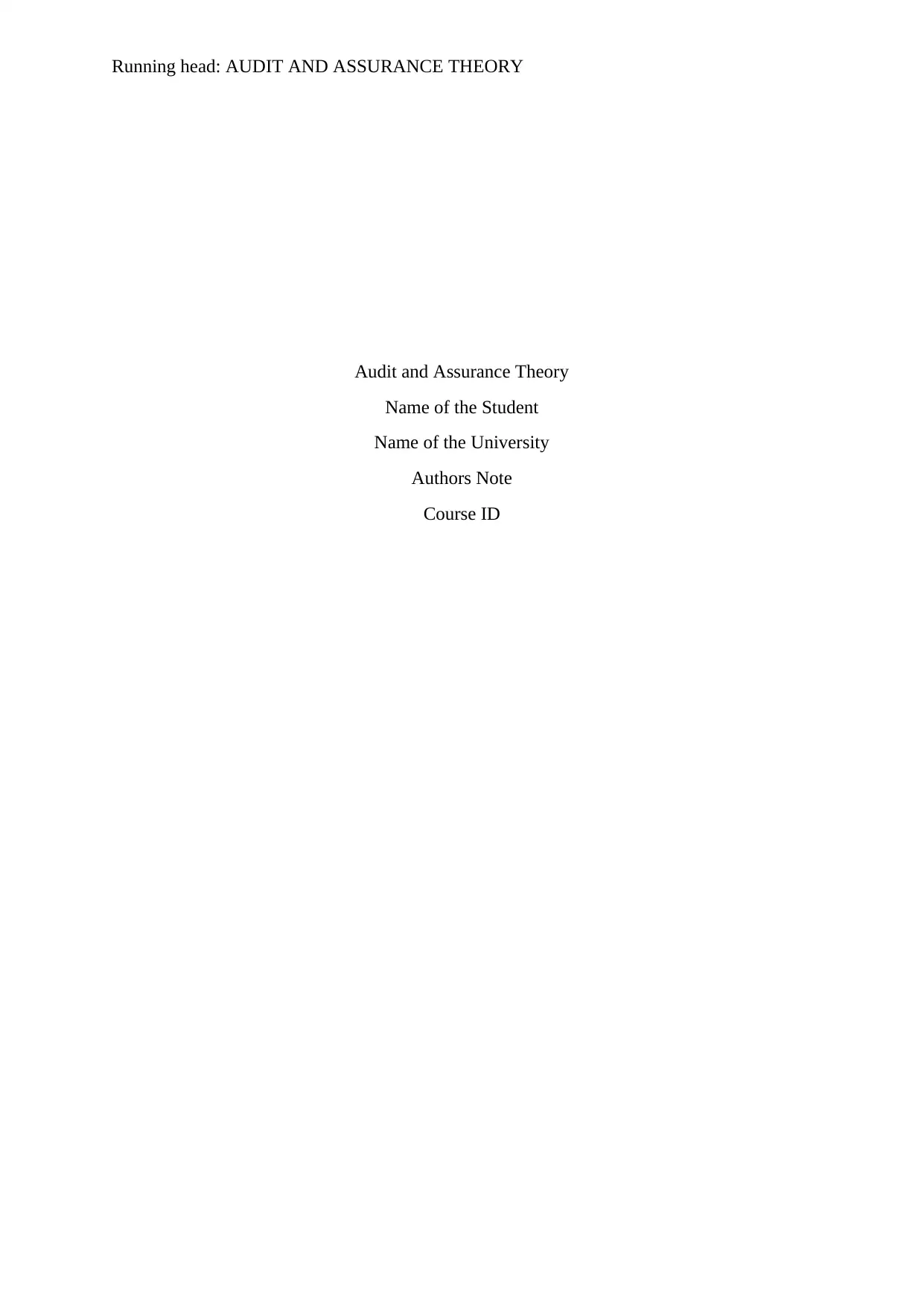
Running head: AUDIT AND ASSURANCE THEORY
Audit and Assurance Theory
Name of the Student
Name of the University
Authors Note
Course ID
Audit and Assurance Theory
Name of the Student
Name of the University
Authors Note
Course ID
Paraphrase This Document
Need a fresh take? Get an instant paraphrase of this document with our AI Paraphraser
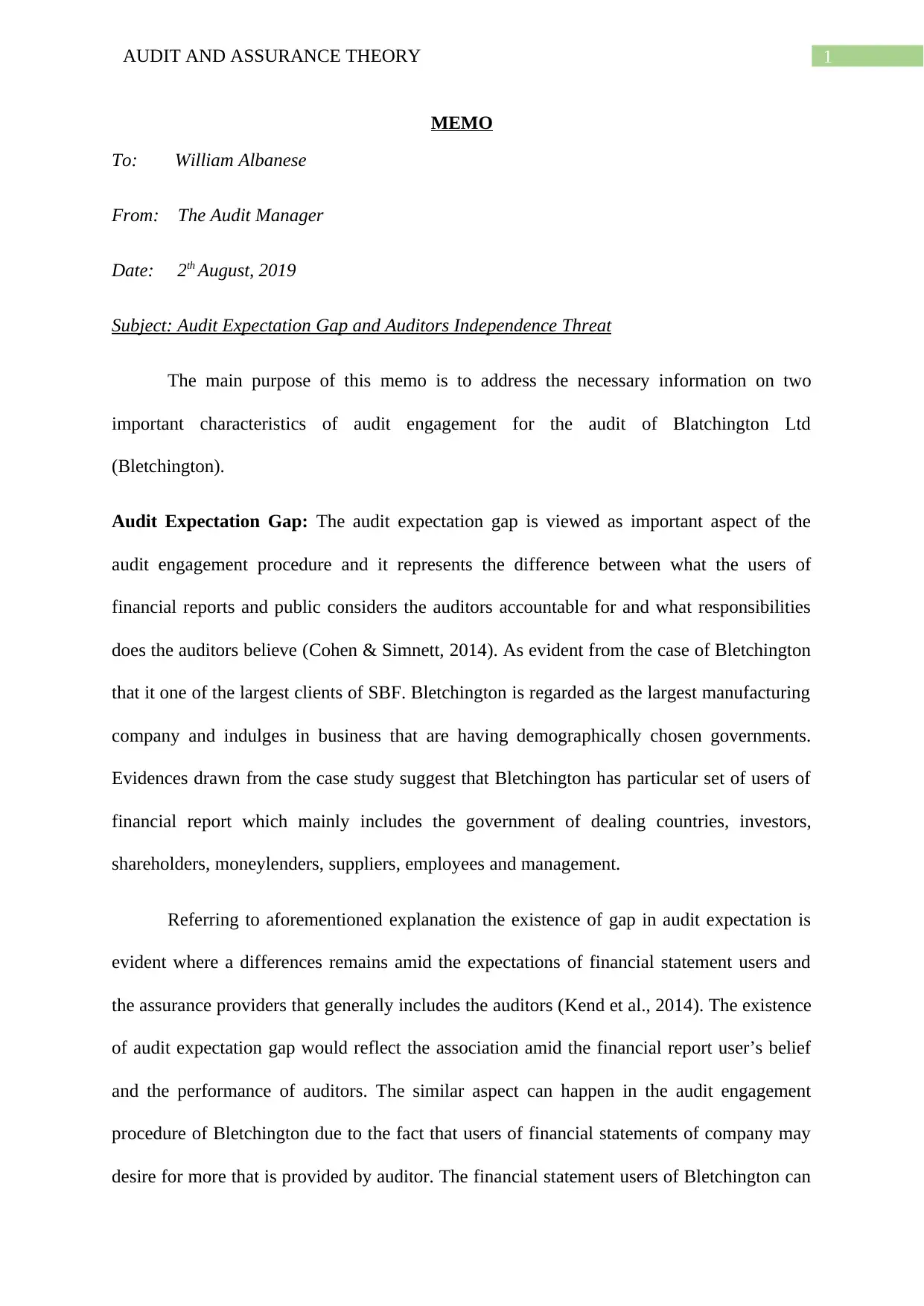
1AUDIT AND ASSURANCE THEORY
MEMO
To: William Albanese
From: The Audit Manager
Date: 2th August, 2019
Subject: Audit Expectation Gap and Auditors Independence Threat
The main purpose of this memo is to address the necessary information on two
important characteristics of audit engagement for the audit of Blatchington Ltd
(Bletchington).
Audit Expectation Gap: The audit expectation gap is viewed as important aspect of the
audit engagement procedure and it represents the difference between what the users of
financial reports and public considers the auditors accountable for and what responsibilities
does the auditors believe (Cohen & Simnett, 2014). As evident from the case of Bletchington
that it one of the largest clients of SBF. Bletchington is regarded as the largest manufacturing
company and indulges in business that are having demographically chosen governments.
Evidences drawn from the case study suggest that Bletchington has particular set of users of
financial report which mainly includes the government of dealing countries, investors,
shareholders, moneylenders, suppliers, employees and management.
Referring to aforementioned explanation the existence of gap in audit expectation is
evident where a differences remains amid the expectations of financial statement users and
the assurance providers that generally includes the auditors (Kend et al., 2014). The existence
of audit expectation gap would reflect the association amid the financial report user’s belief
and the performance of auditors. The similar aspect can happen in the audit engagement
procedure of Bletchington due to the fact that users of financial statements of company may
desire for more that is provided by auditor. The financial statement users of Bletchington can
MEMO
To: William Albanese
From: The Audit Manager
Date: 2th August, 2019
Subject: Audit Expectation Gap and Auditors Independence Threat
The main purpose of this memo is to address the necessary information on two
important characteristics of audit engagement for the audit of Blatchington Ltd
(Bletchington).
Audit Expectation Gap: The audit expectation gap is viewed as important aspect of the
audit engagement procedure and it represents the difference between what the users of
financial reports and public considers the auditors accountable for and what responsibilities
does the auditors believe (Cohen & Simnett, 2014). As evident from the case of Bletchington
that it one of the largest clients of SBF. Bletchington is regarded as the largest manufacturing
company and indulges in business that are having demographically chosen governments.
Evidences drawn from the case study suggest that Bletchington has particular set of users of
financial report which mainly includes the government of dealing countries, investors,
shareholders, moneylenders, suppliers, employees and management.
Referring to aforementioned explanation the existence of gap in audit expectation is
evident where a differences remains amid the expectations of financial statement users and
the assurance providers that generally includes the auditors (Kend et al., 2014). The existence
of audit expectation gap would reflect the association amid the financial report user’s belief
and the performance of auditors. The similar aspect can happen in the audit engagement
procedure of Bletchington due to the fact that users of financial statements of company may
desire for more that is provided by auditor. The financial statement users of Bletchington can
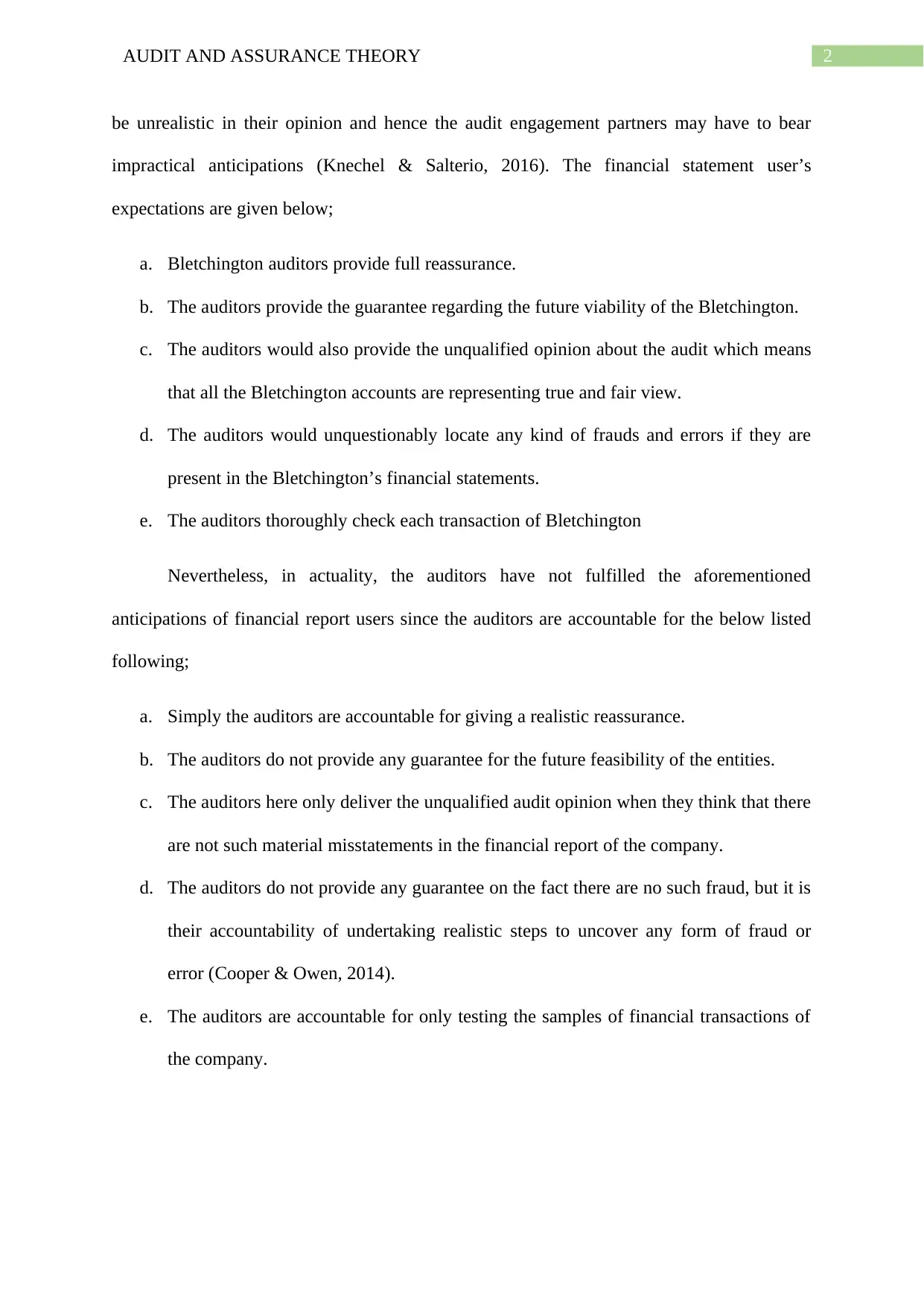
2AUDIT AND ASSURANCE THEORY
be unrealistic in their opinion and hence the audit engagement partners may have to bear
impractical anticipations (Knechel & Salterio, 2016). The financial statement user’s
expectations are given below;
a. Bletchington auditors provide full reassurance.
b. The auditors provide the guarantee regarding the future viability of the Bletchington.
c. The auditors would also provide the unqualified opinion about the audit which means
that all the Bletchington accounts are representing true and fair view.
d. The auditors would unquestionably locate any kind of frauds and errors if they are
present in the Bletchington’s financial statements.
e. The auditors thoroughly check each transaction of Bletchington
Nevertheless, in actuality, the auditors have not fulfilled the aforementioned
anticipations of financial report users since the auditors are accountable for the below listed
following;
a. Simply the auditors are accountable for giving a realistic reassurance.
b. The auditors do not provide any guarantee for the future feasibility of the entities.
c. The auditors here only deliver the unqualified audit opinion when they think that there
are not such material misstatements in the financial report of the company.
d. The auditors do not provide any guarantee on the fact there are no such fraud, but it is
their accountability of undertaking realistic steps to uncover any form of fraud or
error (Cooper & Owen, 2014).
e. The auditors are accountable for only testing the samples of financial transactions of
the company.
be unrealistic in their opinion and hence the audit engagement partners may have to bear
impractical anticipations (Knechel & Salterio, 2016). The financial statement user’s
expectations are given below;
a. Bletchington auditors provide full reassurance.
b. The auditors provide the guarantee regarding the future viability of the Bletchington.
c. The auditors would also provide the unqualified opinion about the audit which means
that all the Bletchington accounts are representing true and fair view.
d. The auditors would unquestionably locate any kind of frauds and errors if they are
present in the Bletchington’s financial statements.
e. The auditors thoroughly check each transaction of Bletchington
Nevertheless, in actuality, the auditors have not fulfilled the aforementioned
anticipations of financial report users since the auditors are accountable for the below listed
following;
a. Simply the auditors are accountable for giving a realistic reassurance.
b. The auditors do not provide any guarantee for the future feasibility of the entities.
c. The auditors here only deliver the unqualified audit opinion when they think that there
are not such material misstatements in the financial report of the company.
d. The auditors do not provide any guarantee on the fact there are no such fraud, but it is
their accountability of undertaking realistic steps to uncover any form of fraud or
error (Cooper & Owen, 2014).
e. The auditors are accountable for only testing the samples of financial transactions of
the company.
⊘ This is a preview!⊘
Do you want full access?
Subscribe today to unlock all pages.

Trusted by 1+ million students worldwide
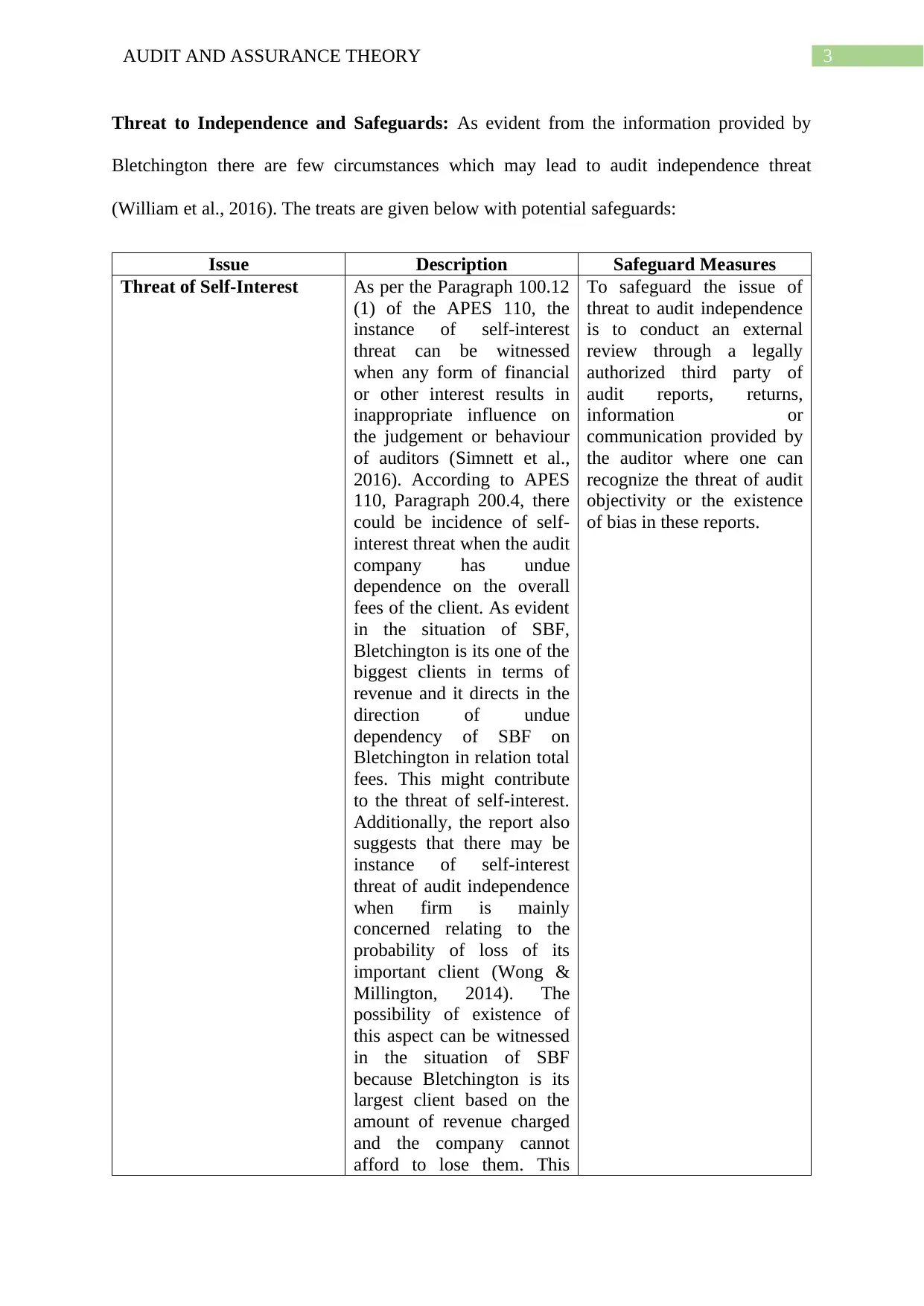
3AUDIT AND ASSURANCE THEORY
Threat to Independence and Safeguards: As evident from the information provided by
Bletchington there are few circumstances which may lead to audit independence threat
(William et al., 2016). The treats are given below with potential safeguards:
Issue Description Safeguard Measures
Threat of Self-Interest As per the Paragraph 100.12
(1) of the APES 110, the
instance of self-interest
threat can be witnessed
when any form of financial
or other interest results in
inappropriate influence on
the judgement or behaviour
of auditors (Simnett et al.,
2016). According to APES
110, Paragraph 200.4, there
could be incidence of self-
interest threat when the audit
company has undue
dependence on the overall
fees of the client. As evident
in the situation of SBF,
Bletchington is its one of the
biggest clients in terms of
revenue and it directs in the
direction of undue
dependency of SBF on
Bletchington in relation total
fees. This might contribute
to the threat of self-interest.
Additionally, the report also
suggests that there may be
instance of self-interest
threat of audit independence
when firm is mainly
concerned relating to the
probability of loss of its
important client (Wong &
Millington, 2014). The
possibility of existence of
this aspect can be witnessed
in the situation of SBF
because Bletchington is its
largest client based on the
amount of revenue charged
and the company cannot
afford to lose them. This
To safeguard the issue of
threat to audit independence
is to conduct an external
review through a legally
authorized third party of
audit reports, returns,
information or
communication provided by
the auditor where one can
recognize the threat of audit
objectivity or the existence
of bias in these reports.
Threat to Independence and Safeguards: As evident from the information provided by
Bletchington there are few circumstances which may lead to audit independence threat
(William et al., 2016). The treats are given below with potential safeguards:
Issue Description Safeguard Measures
Threat of Self-Interest As per the Paragraph 100.12
(1) of the APES 110, the
instance of self-interest
threat can be witnessed
when any form of financial
or other interest results in
inappropriate influence on
the judgement or behaviour
of auditors (Simnett et al.,
2016). According to APES
110, Paragraph 200.4, there
could be incidence of self-
interest threat when the audit
company has undue
dependence on the overall
fees of the client. As evident
in the situation of SBF,
Bletchington is its one of the
biggest clients in terms of
revenue and it directs in the
direction of undue
dependency of SBF on
Bletchington in relation total
fees. This might contribute
to the threat of self-interest.
Additionally, the report also
suggests that there may be
instance of self-interest
threat of audit independence
when firm is mainly
concerned relating to the
probability of loss of its
important client (Wong &
Millington, 2014). The
possibility of existence of
this aspect can be witnessed
in the situation of SBF
because Bletchington is its
largest client based on the
amount of revenue charged
and the company cannot
afford to lose them. This
To safeguard the issue of
threat to audit independence
is to conduct an external
review through a legally
authorized third party of
audit reports, returns,
information or
communication provided by
the auditor where one can
recognize the threat of audit
objectivity or the existence
of bias in these reports.
Paraphrase This Document
Need a fresh take? Get an instant paraphrase of this document with our AI Paraphraser
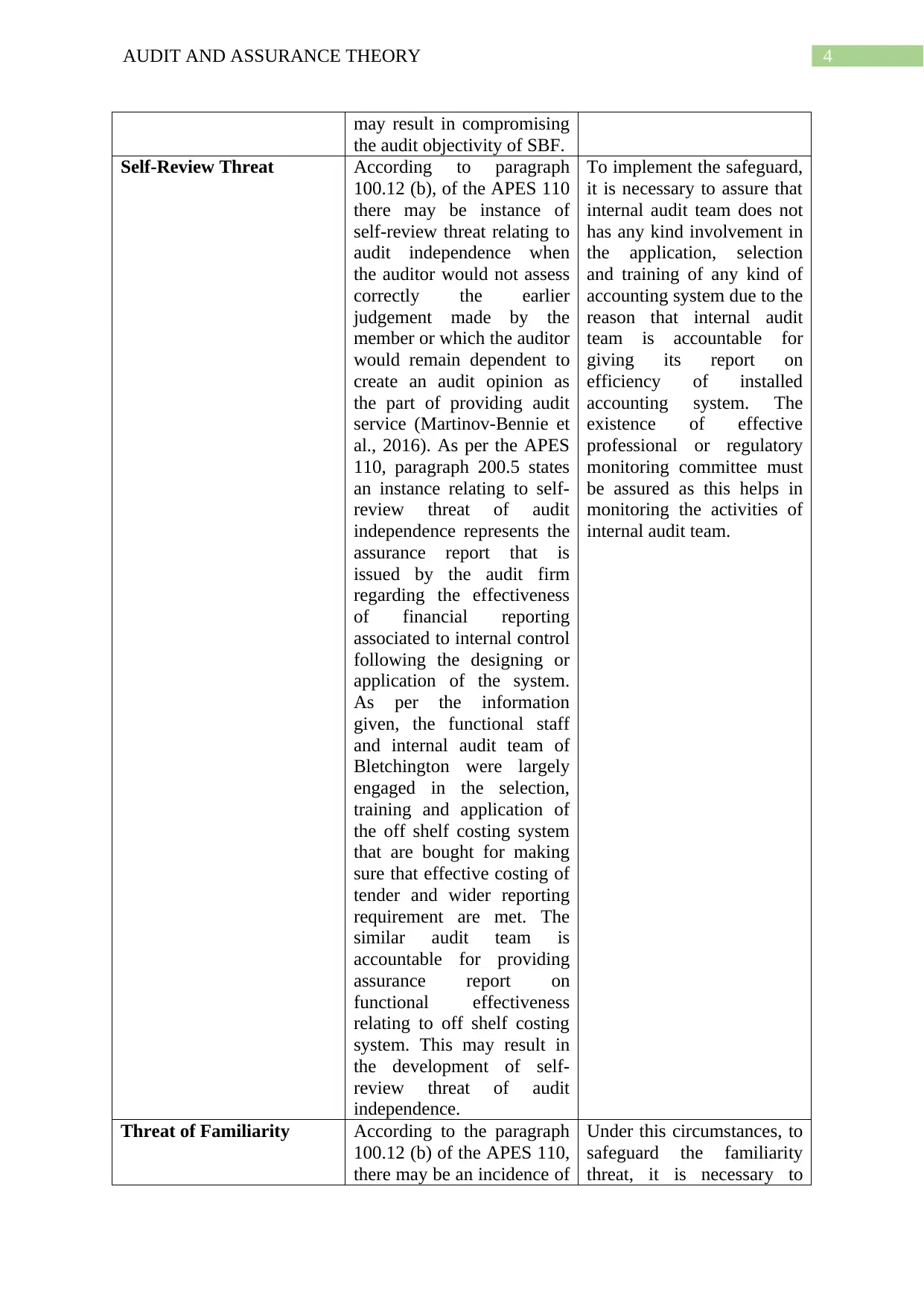
4AUDIT AND ASSURANCE THEORY
may result in compromising
the audit objectivity of SBF.
Self-Review Threat According to paragraph
100.12 (b), of the APES 110
there may be instance of
self-review threat relating to
audit independence when
the auditor would not assess
correctly the earlier
judgement made by the
member or which the auditor
would remain dependent to
create an audit opinion as
the part of providing audit
service (Martinov-Bennie et
al., 2016). As per the APES
110, paragraph 200.5 states
an instance relating to self-
review threat of audit
independence represents the
assurance report that is
issued by the audit firm
regarding the effectiveness
of financial reporting
associated to internal control
following the designing or
application of the system.
As per the information
given, the functional staff
and internal audit team of
Bletchington were largely
engaged in the selection,
training and application of
the off shelf costing system
that are bought for making
sure that effective costing of
tender and wider reporting
requirement are met. The
similar audit team is
accountable for providing
assurance report on
functional effectiveness
relating to off shelf costing
system. This may result in
the development of self-
review threat of audit
independence.
To implement the safeguard,
it is necessary to assure that
internal audit team does not
has any kind involvement in
the application, selection
and training of any kind of
accounting system due to the
reason that internal audit
team is accountable for
giving its report on
efficiency of installed
accounting system. The
existence of effective
professional or regulatory
monitoring committee must
be assured as this helps in
monitoring the activities of
internal audit team.
Threat of Familiarity According to the paragraph
100.12 (b) of the APES 110,
there may be an incidence of
Under this circumstances, to
safeguard the familiarity
threat, it is necessary to
may result in compromising
the audit objectivity of SBF.
Self-Review Threat According to paragraph
100.12 (b), of the APES 110
there may be instance of
self-review threat relating to
audit independence when
the auditor would not assess
correctly the earlier
judgement made by the
member or which the auditor
would remain dependent to
create an audit opinion as
the part of providing audit
service (Martinov-Bennie et
al., 2016). As per the APES
110, paragraph 200.5 states
an instance relating to self-
review threat of audit
independence represents the
assurance report that is
issued by the audit firm
regarding the effectiveness
of financial reporting
associated to internal control
following the designing or
application of the system.
As per the information
given, the functional staff
and internal audit team of
Bletchington were largely
engaged in the selection,
training and application of
the off shelf costing system
that are bought for making
sure that effective costing of
tender and wider reporting
requirement are met. The
similar audit team is
accountable for providing
assurance report on
functional effectiveness
relating to off shelf costing
system. This may result in
the development of self-
review threat of audit
independence.
To implement the safeguard,
it is necessary to assure that
internal audit team does not
has any kind involvement in
the application, selection
and training of any kind of
accounting system due to the
reason that internal audit
team is accountable for
giving its report on
efficiency of installed
accounting system. The
existence of effective
professional or regulatory
monitoring committee must
be assured as this helps in
monitoring the activities of
internal audit team.
Threat of Familiarity According to the paragraph
100.12 (b) of the APES 110,
there may be an incidence of
Under this circumstances, to
safeguard the familiarity
threat, it is necessary to
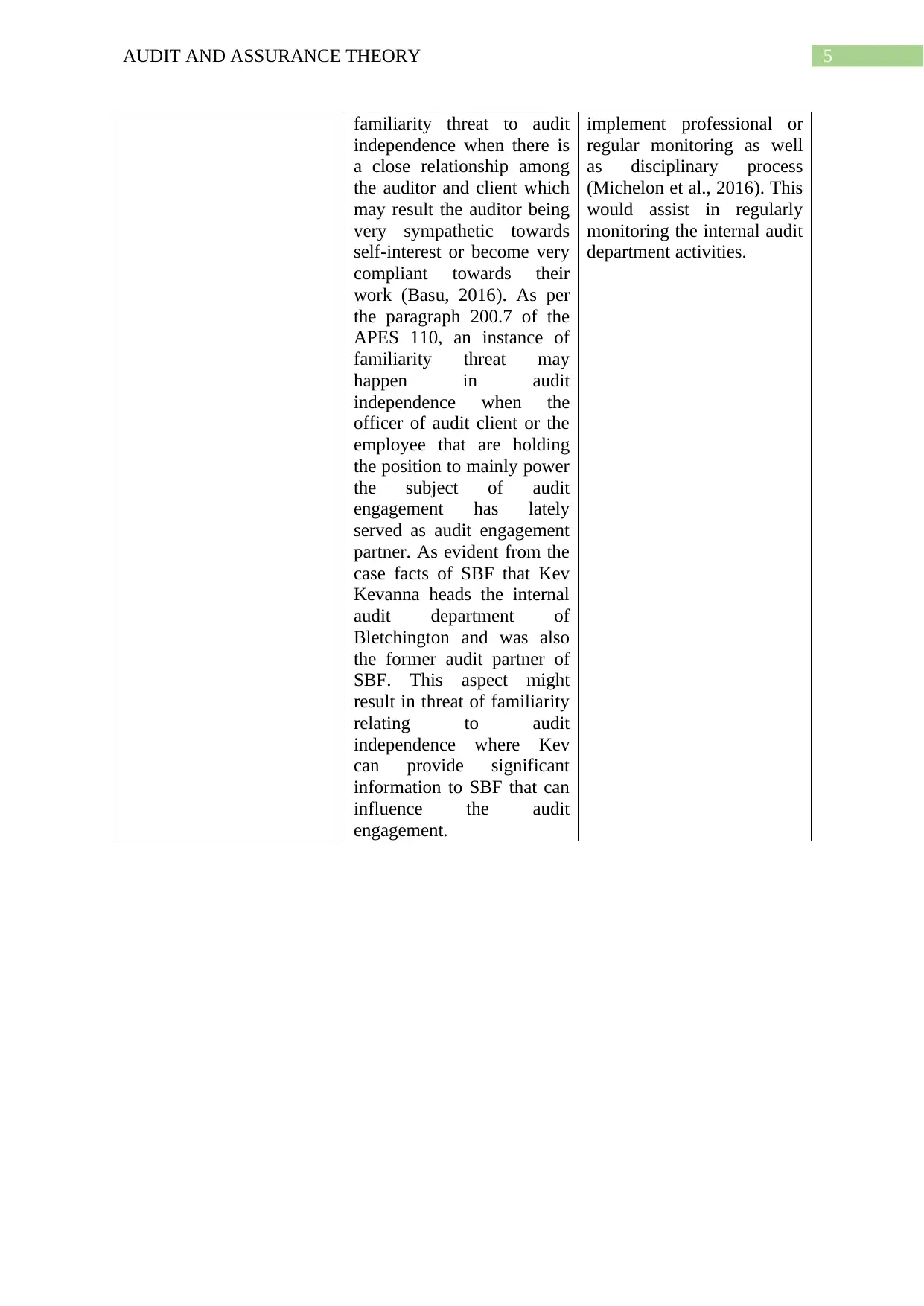
5AUDIT AND ASSURANCE THEORY
familiarity threat to audit
independence when there is
a close relationship among
the auditor and client which
may result the auditor being
very sympathetic towards
self-interest or become very
compliant towards their
work (Basu, 2016). As per
the paragraph 200.7 of the
APES 110, an instance of
familiarity threat may
happen in audit
independence when the
officer of audit client or the
employee that are holding
the position to mainly power
the subject of audit
engagement has lately
served as audit engagement
partner. As evident from the
case facts of SBF that Kev
Kevanna heads the internal
audit department of
Bletchington and was also
the former audit partner of
SBF. This aspect might
result in threat of familiarity
relating to audit
independence where Kev
can provide significant
information to SBF that can
influence the audit
engagement.
implement professional or
regular monitoring as well
as disciplinary process
(Michelon et al., 2016). This
would assist in regularly
monitoring the internal audit
department activities.
familiarity threat to audit
independence when there is
a close relationship among
the auditor and client which
may result the auditor being
very sympathetic towards
self-interest or become very
compliant towards their
work (Basu, 2016). As per
the paragraph 200.7 of the
APES 110, an instance of
familiarity threat may
happen in audit
independence when the
officer of audit client or the
employee that are holding
the position to mainly power
the subject of audit
engagement has lately
served as audit engagement
partner. As evident from the
case facts of SBF that Kev
Kevanna heads the internal
audit department of
Bletchington and was also
the former audit partner of
SBF. This aspect might
result in threat of familiarity
relating to audit
independence where Kev
can provide significant
information to SBF that can
influence the audit
engagement.
implement professional or
regular monitoring as well
as disciplinary process
(Michelon et al., 2016). This
would assist in regularly
monitoring the internal audit
department activities.
⊘ This is a preview!⊘
Do you want full access?
Subscribe today to unlock all pages.

Trusted by 1+ million students worldwide
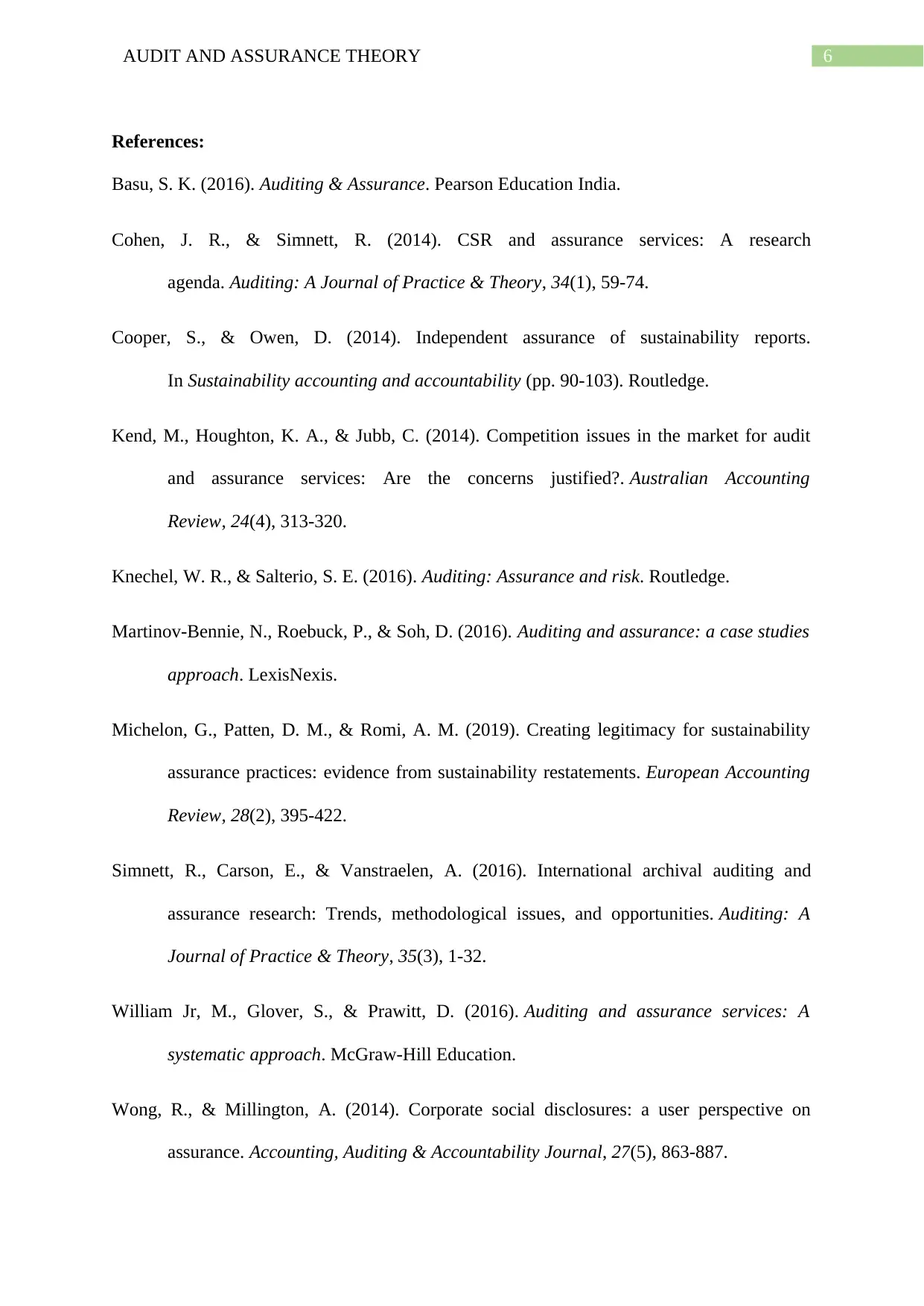
6AUDIT AND ASSURANCE THEORY
References:
Basu, S. K. (2016). Auditing & Assurance. Pearson Education India.
Cohen, J. R., & Simnett, R. (2014). CSR and assurance services: A research
agenda. Auditing: A Journal of Practice & Theory, 34(1), 59-74.
Cooper, S., & Owen, D. (2014). Independent assurance of sustainability reports.
In Sustainability accounting and accountability (pp. 90-103). Routledge.
Kend, M., Houghton, K. A., & Jubb, C. (2014). Competition issues in the market for audit
and assurance services: Are the concerns justified?. Australian Accounting
Review, 24(4), 313-320.
Knechel, W. R., & Salterio, S. E. (2016). Auditing: Assurance and risk. Routledge.
Martinov-Bennie, N., Roebuck, P., & Soh, D. (2016). Auditing and assurance: a case studies
approach. LexisNexis.
Michelon, G., Patten, D. M., & Romi, A. M. (2019). Creating legitimacy for sustainability
assurance practices: evidence from sustainability restatements. European Accounting
Review, 28(2), 395-422.
Simnett, R., Carson, E., & Vanstraelen, A. (2016). International archival auditing and
assurance research: Trends, methodological issues, and opportunities. Auditing: A
Journal of Practice & Theory, 35(3), 1-32.
William Jr, M., Glover, S., & Prawitt, D. (2016). Auditing and assurance services: A
systematic approach. McGraw-Hill Education.
Wong, R., & Millington, A. (2014). Corporate social disclosures: a user perspective on
assurance. Accounting, Auditing & Accountability Journal, 27(5), 863-887.
References:
Basu, S. K. (2016). Auditing & Assurance. Pearson Education India.
Cohen, J. R., & Simnett, R. (2014). CSR and assurance services: A research
agenda. Auditing: A Journal of Practice & Theory, 34(1), 59-74.
Cooper, S., & Owen, D. (2014). Independent assurance of sustainability reports.
In Sustainability accounting and accountability (pp. 90-103). Routledge.
Kend, M., Houghton, K. A., & Jubb, C. (2014). Competition issues in the market for audit
and assurance services: Are the concerns justified?. Australian Accounting
Review, 24(4), 313-320.
Knechel, W. R., & Salterio, S. E. (2016). Auditing: Assurance and risk. Routledge.
Martinov-Bennie, N., Roebuck, P., & Soh, D. (2016). Auditing and assurance: a case studies
approach. LexisNexis.
Michelon, G., Patten, D. M., & Romi, A. M. (2019). Creating legitimacy for sustainability
assurance practices: evidence from sustainability restatements. European Accounting
Review, 28(2), 395-422.
Simnett, R., Carson, E., & Vanstraelen, A. (2016). International archival auditing and
assurance research: Trends, methodological issues, and opportunities. Auditing: A
Journal of Practice & Theory, 35(3), 1-32.
William Jr, M., Glover, S., & Prawitt, D. (2016). Auditing and assurance services: A
systematic approach. McGraw-Hill Education.
Wong, R., & Millington, A. (2014). Corporate social disclosures: a user perspective on
assurance. Accounting, Auditing & Accountability Journal, 27(5), 863-887.
Paraphrase This Document
Need a fresh take? Get an instant paraphrase of this document with our AI Paraphraser
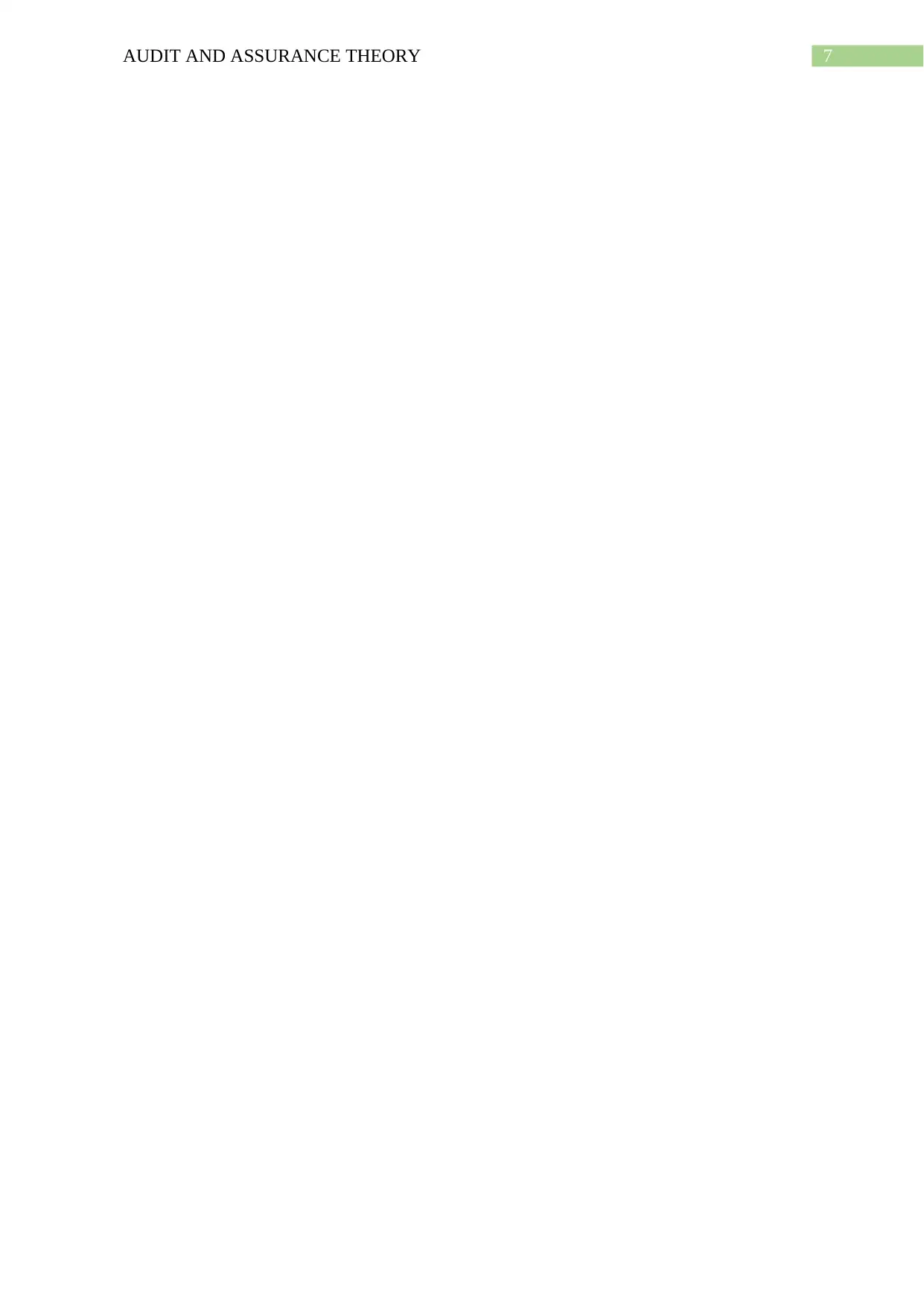
7AUDIT AND ASSURANCE THEORY
1 out of 8
Related Documents
Your All-in-One AI-Powered Toolkit for Academic Success.
+13062052269
info@desklib.com
Available 24*7 on WhatsApp / Email
![[object Object]](/_next/static/media/star-bottom.7253800d.svg)
Unlock your academic potential
Copyright © 2020–2025 A2Z Services. All Rights Reserved. Developed and managed by ZUCOL.





